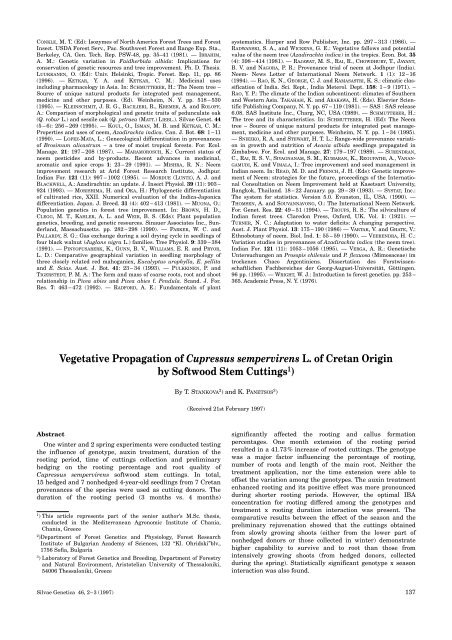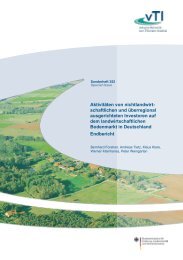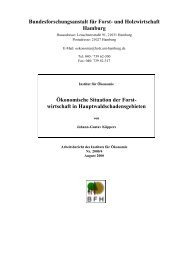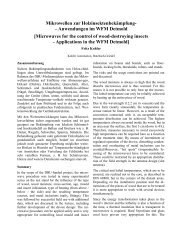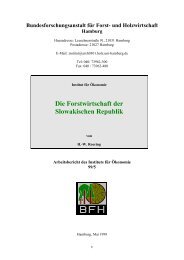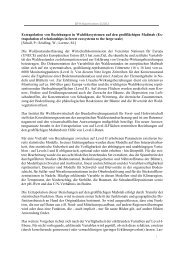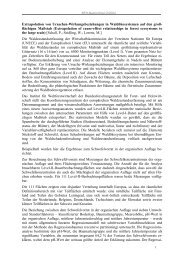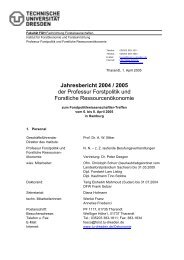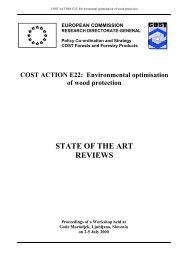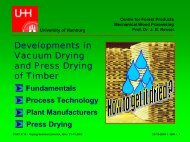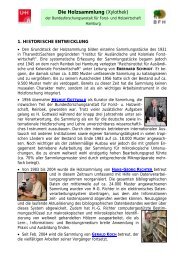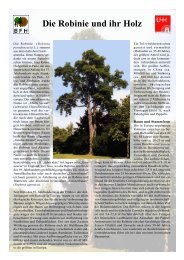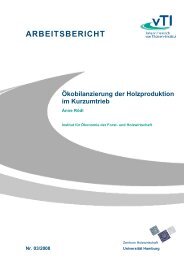Vegetative Propagation of Cupressus sempervirens
Vegetative Propagation of Cupressus sempervirens
Vegetative Propagation of Cupressus sempervirens
Create successful ePaper yourself
Turn your PDF publications into a flip-book with our unique Google optimized e-Paper software.
CONKLE, M. T. (Ed): Isozymes <strong>of</strong> North America Forest Trees and Forest<br />
Insect. USDA Forest Serv., Pac. Southwest Forest and Range Exp. Sta.,<br />
Berkeley, CA. Gen. Tech. Rep. PSW-48, pp. 35–41 (1981). — IBRAHIM,<br />
A. M.: Genetic variation in Faidherbida albida: Implications for<br />
conservation <strong>of</strong> genetic resources and tree improvement. Ph. D. Thesis.<br />
LUUKKANEN, O. (Ed): Univ. Helsinki, Tropic. Forest. Rep. 11, pp. 86<br />
(1996). — KETKAR, Y. A. and KETKAR, C. M.: Medicinal uses<br />
including pharmacology in Asia. In: SCHMUTTERER, H.: The Neem tree –<br />
Source <strong>of</strong> unique natural products for integrated pest management,<br />
medicine and other purposes. (Ed). Weinheim, N. Y. pp. 518 – 530<br />
(1995). — KLEINSCHMIT, J. R. G., BACILIERI, R., KREMER, A. and ROLOFF,<br />
A.: Comparison <strong>of</strong> morphological and genetic traits <strong>of</strong> pedunculate oak<br />
(Q. robur L.) and sessile oak (Q. petraea (MATT.) LIEBL.). Silvae Genet. 44<br />
(5 – 6): 256 – 269 (1995). — KOUL, O., ISMAN, M. B. and KETKAR, C. M.:<br />
Properties and uses <strong>of</strong> neem, Azadirachta indica. Can. J. Bot. 68: 1 –11<br />
(1990). — LOPEZ-MATA, L.: Genecological differentiation in provenances<br />
<strong>of</strong> Brosimum alicastrum – a tree <strong>of</strong> moist tropical forests. For. Ecol.<br />
Manage. 21: 197 – 208 (1987). — MARAMOROSCH, K.: Current status <strong>of</strong><br />
neem pesticides and by-products. Recent advances in medicinal,<br />
aromatic and spice crops 1: 23 – 29 (1991). — MISHRA, R. N.: Neem<br />
improvement research at Arid Forest Research Institute, Jodhpur.<br />
Indian For. 121 (11): 997 – 1002 (1995). — MORDUE (LUNTZ), A. J. and<br />
BLACKWELL, A.: Azadirachtin: an update. J. Insect Physiol. 39 (11): 903 –<br />
924 (1993). — MORISHIMA, H. and OKA, H.: Phylogenetic differentiation<br />
<strong>of</strong> cultivated rice, XXII. Numerical evaluation <strong>of</strong> the Indica-Japonica<br />
differentiation. Japan. J. Breed. 31 (4): 402 – 413 (1981). — MUONA, O.:<br />
Population genetics in forest tree improvement. In: BROWN, H. D.,<br />
CLEGG, M. T., KAHLER, A. L. and WEIR, B. S. (Eds): Plant population<br />
genetics, breeding, and genetic resources. Sinauer Associates Inc., Sunderland,<br />
Massachusetts. pp. 282 – 298 (1990). — PARKER, W. C. and<br />
PALLARDY, S. G.: Gas exchange during a soil drying cycle in seedlings <strong>of</strong><br />
four black walnut (Juglans nigra L.) families. Tree Physiol. 9: 339 – 384<br />
(1991). — PINYOPUSARERK, K., GUNN, B. V., WILLIAMS, E. R. and PRYOR,<br />
L. D.: Comparative geographical variation in seedling morphology <strong>of</strong><br />
three closely related red mahoganiex, Eucalyptus urophylla, E. pellita<br />
and E. Scias. Aust. J. Bot. 41: 23 – 34 (1993). — PULKKINEN, P. and<br />
TIGERSTEDT, P. M. A.: The form and mass <strong>of</strong> coarse roots, root and shoot<br />
relationship in Picea abies and Picea abies f. Pendula. Scand. J. For.<br />
Res. 7: 463 – 472 (1992). — RADFORD, A. E.: Fundamentals <strong>of</strong> plant<br />
Abstract<br />
One winter and 2 spring experiments were conducted testing<br />
the influence <strong>of</strong> genotype, auxin treatment, duration <strong>of</strong> the<br />
rooting period, time <strong>of</strong> cuttings collection and preliminary<br />
hedging on the rooting percentage and root quality <strong>of</strong><br />
<strong>Cupressus</strong> <strong>sempervirens</strong> s<strong>of</strong>twood stem cuttings. In total,<br />
15 hedged and 7 nonhedged 4-year-old seedlings from 7 Cretan<br />
provenances <strong>of</strong> the species were used as cutting donors. The<br />
duration <strong>of</strong> the rooting period (3 months vs. 4 months)<br />
systematics. Harper and Row Publisher, Inc. pp. 297 – 313 (1986). —<br />
RADWANSKI, S. A., and WICKENS, G. E.: <strong>Vegetative</strong> fallows and potential<br />
value <strong>of</strong> the neem tree (Azadirachta indica) in the tropics. Econ. Bot. 35<br />
(4): 398 – 414 (1981). — RAJAWAT, M. S., RAI, R., CHOWDHURY, T., JAYANT,<br />
B. V. and NAGORA, P. R.: Provenance trial <strong>of</strong> neem at Jodhpur (India).<br />
Neem- News Letter <strong>of</strong> International Neem Network. 1 (1): 12 –16<br />
(1994). — RAO, K. N., GEORGE, C. J. and RAMASASTRI, K. S.: climatic classification<br />
<strong>of</strong> India. Sci. Rept., India Meterol. Dept. 158: 1 – 9 (1971). –<br />
RAO, Y. P.: The climate <strong>of</strong> the Indian subcontinent: climates <strong>of</strong> Southern<br />
and Western Asia. TAKAHASI, K. and ARAKAWA, H. (Eds). Elsevier Scientific<br />
Publishing Company, N. Y. pp. 67 – 119 (1981). — SAS : SAS release<br />
6.08. SAS Institute Inc., Charg, NC, USA (1989). — SCHMUTTERER, H.:<br />
The tree and its characteristics. In: SCHMUTTERER, H. (Ed): The Neem<br />
tree – Source <strong>of</strong> unique natural products for integrated pest management,<br />
medicine and other purposes. Weinheim, N. Y. pp. 1 – 34 (1995).<br />
— SNIEZKO, R. A. and STEWART, H. T. L.: Range-wide provenance variation<br />
in growth and nutrition <strong>of</strong> Acacia albida seedlings propagated in<br />
Zimbabwe. For. Ecol. and Manage. 27: 179 –197 (1989). — SURENDRAN,<br />
C., RAI, R. S. V., SIVAGNANAM, S. M., KUMARAN, K., REGUPATHI, A., VANAN-<br />
GAMUDI, K. and VIMALA, I.: Tree improvement and seed management in<br />
Indian neem. In: READ, M. D. and FRENCH, J. H. (Eds): Genetic improvement<br />
<strong>of</strong> Neem: strategies for the future, proceedings <strong>of</strong> the International<br />
Consultation on Neem Improvement held at Kasetsart University,<br />
Bangkok, Thailand. 18 – 22 January. pp. 29 – 39 (1993). — SYSTAT, Inc.:<br />
The system for statistics. Version 5.0. Evanston, IL, USA. (1990). —<br />
THOMSEN, A. and SOUVANNAVONG, O.: The International Neem Network.<br />
For. Genet. Res. 22: 49 – 51 (1994). — TROUPS, R. S.: The silviculture <strong>of</strong><br />
Indian forest trees. Claredon Press, Oxford, UK. Vol. 1: (1921). —<br />
TURNER, N. C.: Adaptation to water deficits: A changing perspective.<br />
Aust. J. Plant Physiol. 13: 175 – 190 (1986) — VARTAK, V. and GHATE, V.:<br />
Ethnobotany <strong>of</strong> neem. Biol. Ind. 1: 55 – 59 (1990). — VEERENDRA, H. C.:<br />
Variation studies in provenances <strong>of</strong> Azadirachta indica (the neem tree).<br />
Indian For. 121 (11): 1053 –1056 (1995). — VERGA, A. R.: Genetische<br />
Untersuchungen an Prosopis chilensis und P. flexuosa (Mimosaceae) im<br />
trockenen Chaco Argentiniens. Dissertation des Forstwissenschaftlichen<br />
Fachbereiches der Georg-August-Universität, Göttingen.<br />
96 pp. (1995). — WRIGHT, W. J.: Introduction to forest genetics. pp. 253 –<br />
365. Academic Press, N. Y. (1976).<br />
<strong>Vegetative</strong> <strong>Propagation</strong> <strong>of</strong> <strong>Cupressus</strong> <strong>sempervirens</strong> L. <strong>of</strong> Cretan Origin<br />
by S<strong>of</strong>twood Stem Cuttings 1 )<br />
1 ) This article represents part <strong>of</strong> the senior author’s M.Sc. thesis,<br />
conducted in the Mediterranean Agronomic Institute <strong>of</strong> Chania,<br />
Chania, Greece<br />
2 )Department <strong>of</strong> Forest Genetics and Physiology, Forest Research<br />
Institute <strong>of</strong> Bulgarian Academy <strong>of</strong> Sciences, 132 “Kl. Ohridski”blv.,<br />
1756 S<strong>of</strong>ia, Bulgaria<br />
3 ) Laboratory <strong>of</strong> Forest Genetics and Breeding, Department <strong>of</strong> Forestry<br />
and Natural Environment, Aristotelian University <strong>of</strong> Thessaloniki,<br />
54006 Thessaloniki, Greece<br />
By T. STANKOVA 2 ) and K. PANETSOS 3 )<br />
(Received 21st February 1997)<br />
significantly affected the rooting and callus formation<br />
percentages. One month extension <strong>of</strong> the rooting period<br />
resulted in a 41.73% increase <strong>of</strong> rooted cuttings. The genotype<br />
was a major factor influencing the percentage <strong>of</strong> rooting,<br />
number <strong>of</strong> roots and length <strong>of</strong> the main root. Neither the<br />
treatment application, nor the time extension were able to<br />
<strong>of</strong>fset the variation among the genotypes. The auxin treatment<br />
enhanced rooting and its positive effect was more pronounced<br />
during shorter rooting periods. However, the optimal IBA<br />
concentration for rooting differed among the genotypes and<br />
treatment x rooting duration interaction was present. The<br />
comparative results between the effect <strong>of</strong> the season and the<br />
preliminary rejuvenation showed that the cuttings obtained<br />
from slowly growing shoots (either from the lower part <strong>of</strong><br />
nonhedged donors or those collected in winter) demonstrate<br />
higher capability to survive and to root than those from<br />
intensively growing shoots (from hedged donors, collected<br />
during the spring). Statistically significant genotype x season<br />
interaction was also found.<br />
Silvae Genetica 46, 2–3 (1997) 137
Key words: <strong>Cupressus</strong> <strong>sempervirens</strong>, cutting propagation, genotype,<br />
indole-3-butyric acid, duration <strong>of</strong> rooting, time <strong>of</strong> cutting collection,<br />
hedging.<br />
FDC: 232.328.1; 165.3; 165.44; 161.4; 181.36; 174.7 <strong>Cupressus</strong><br />
<strong>sempervirens</strong>; (495.9).<br />
Introduction<br />
The Mediterranean cypress (<strong>Cupressus</strong> <strong>sempervirens</strong> L.),<br />
which is an irreplaceable part <strong>of</strong> the Mediterranean region, has<br />
been widely used since ancient times. It is a tree well adapted<br />
to calcareous, dry and poor sites, possessing valuable biological<br />
properties and exceptional timber quality. Extensive<br />
exploitation for millennia, the effect <strong>of</strong> recent pests like the<br />
cypress cancer caused by Seiridium cardinale, accompanied by<br />
the fact that <strong>Cupressus</strong> <strong>sempervirens</strong> has limited natural<br />
distribution compared with the other common s<strong>of</strong>twoods, have<br />
imposed the necessity for the development <strong>of</strong> a breeding<br />
programme for this species.<br />
The use <strong>of</strong> vegetative propagation is <strong>of</strong> vital importance to<br />
tree improvement and has become one <strong>of</strong> the most important<br />
tools <strong>of</strong> the tree improvement forester (ZOBEL and TALBERT,<br />
1984). It can provide new clones <strong>of</strong> <strong>Cupressus</strong> <strong>sempervirens</strong><br />
with superior growth, adapted to adverse ecological conditions<br />
and resistant or tolerant to Seiridium cardinale, which are<br />
needed for environmental protection, preservation <strong>of</strong> the<br />
traditional Mediterranean landscape, timber production and<br />
crop protection as windbreaks.<br />
Natural cypress stands on the island <strong>of</strong> Crete have not<br />
suffered from mass infection by Seiridium cardinale yet<br />
(PAPAGEORGIOU, 1994) and their use in breeding for wood<br />
quality is recommended (PARASKEVOPOULOU, 1987). The present<br />
study investigates the variation in the cuttings rootability<br />
among different genotypes <strong>of</strong> the species <strong>of</strong> Cretan origin. The<br />
influence on the rooting success <strong>of</strong> other exogenous and<br />
endogenous factors, such as: auxin treatment, season <strong>of</strong> cutting<br />
collection, duration <strong>of</strong> rooting and preliminary rejuvenation <strong>of</strong><br />
the donor plants, are studied as well.<br />
Materials and Methods<br />
The experiments were carried out in a rooting bed equipped<br />
with bottom heat and mist system in a greenhouse. Paper pots<br />
(5 cm/5 cm/10 cm) were used to insert the rooting material.<br />
They were filled with substrate, consisting <strong>of</strong> peat and perlite<br />
in 1:1 v/v. During the winter experiment, ground temperature<br />
<strong>of</strong> 22°C ± 4°C and ambient temperature <strong>of</strong> 21°C ± 5°C were<br />
maintained. The spring experiments were performed at 24°C ±<br />
4°C ground temperature and 25°C ± 5°C ambient temperature.<br />
The mist system was adjusted to maintain 95 ± 5% air<br />
humidity. A photoperiod <strong>of</strong> 18 hours was provided with a high<br />
pressure lamp (HPL-N, 400 W) installed at 1.5 m above the<br />
rooting bed.<br />
The cutting donors were chosen among 4-year-old cypress<br />
seedlings grown in the nursery <strong>of</strong> the Mediterranean<br />
Agronomic Institute <strong>of</strong> Chania. Seedlot for the establishment <strong>of</strong><br />
the plantation was collected from 9 natural provenances <strong>of</strong><br />
<strong>Cupressus</strong> <strong>sempervirens</strong> from Western Crete. The seedlings<br />
were either from open-pollinated families (established in<br />
progeny test) or only their provenance origin was known<br />
(included in provenance test). The 220 tallest trees from the<br />
nursery plantation were exposed to preliminary rejuvenation<br />
by hedging twice, in December 1993 and then again in<br />
September 1994.<br />
In Experiment 1, 15 genotypes (denoted as G1 to G15 –<br />
Table 1) from 6 provenances were used as cutting donors. They<br />
were chosen among the hedged seedlings considering as a<br />
138<br />
criterion the possibility to provide sufficient number <strong>of</strong> good<br />
quality s<strong>of</strong>twood stem cuttings for propagation. In Experiment<br />
2, 6 <strong>of</strong> the 15 genotypes in Experiment 1 (1 per provenance)<br />
were repeated as ortets (Table 1). In Experiment 3, the rooting<br />
material was obtained from the lower part <strong>of</strong> 7 nonhedged<br />
seedlings (1.5 m to 2 m in height). The ortets (denoted as N1 to<br />
N7 – Table 1) were selected from different provenances, having<br />
intensive primary growth and providing sufficient number <strong>of</strong><br />
cuttings.<br />
Table 1. – Genotypes used in the rooting experiments.<br />
Experiment 1 was conducted during the winter (starting on<br />
16 December 1994). The rooting ability <strong>of</strong> the 15 chosen<br />
genotypes <strong>of</strong> <strong>Cupressus</strong> <strong>sempervirens</strong> was studied at different<br />
concentrations <strong>of</strong> IBA and durations <strong>of</strong> rooting. Six <strong>of</strong> the<br />
genotypes (those which were included in Experiment 2) were<br />
also used in the study <strong>of</strong> the seasonal changes in the<br />
rootability. Experiments 2 and 3 were carried out during the<br />
spring (starting on 17 April 1995). The rooting ability <strong>of</strong> the<br />
genotypes at different concentrations <strong>of</strong> IBA was examined for<br />
the influence <strong>of</strong> the time <strong>of</strong> the cuttings collection (Experiments<br />
1 and 2) and the type <strong>of</strong> the donor plant, either hedged or nonhedged<br />
ortets (Experiments 2 and 3).<br />
Homogeneous s<strong>of</strong>twood cuttings 12 cm to 15 cm in length<br />
and 2 mm to 4 mm in diameter were prepared. The cuttings<br />
from each genotype were grouped in three bundles, one <strong>of</strong><br />
which was left as a control while the other 2 were treated by<br />
basal dip in concentrated solution (2000 ppm or 4000 ppm) <strong>of</strong><br />
indole-3-butyric acid (IBA) for 5 seconds.<br />
The bundles were left to dry for 2 minutes under cover and<br />
all 3 groups were swirled in captan powder (25% captan) before<br />
being placed in the rooting medium. During the period <strong>of</strong> the<br />
experiment the cuttings were sprayed with water solution <strong>of</strong><br />
captan (1.5 g/l) at 2-week intervals. The application <strong>of</strong><br />
combined NPK (20:5:30) fertilizer (2 g/l) at 10-day intervals<br />
started one and a half months after the initiation <strong>of</strong> the<br />
experiment and continued until the end.<br />
The experiments continued for 3 (Experiments 2 and 3) to<br />
4 (Experiment 1) months. By the end <strong>of</strong> the third month, all<br />
cuttings were examined for rooting and the percentage <strong>of</strong><br />
rooting, percentage <strong>of</strong> callus formation, number <strong>of</strong> roots and<br />
length <strong>of</strong> the main root were recorded. The non-rooted cuttings<br />
<strong>of</strong> Experiment 1 were left in the rooting bed and checked for<br />
rooting and callus formation 1 month later.<br />
The experiments were performed in split-plot design with<br />
3 replications. The main plots-genotypes, arranged randomly
in each replication, were divided into sub-plots, randomly<br />
assigned to the 3 different treatments. The small size <strong>of</strong> the<br />
donor plants did not allow more than 3 cuttings per sub-plot to<br />
be used.<br />
The data for Experiment 3 and for each rooting period <strong>of</strong><br />
Experiment 1 (3 months and 4 months, respectively) were<br />
subjected separately to Analysis <strong>of</strong> variance (ANOVA) for splitplot<br />
design (STEEL and TORRIE, 1980; SNEDECOR and COCHRAN,<br />
1989), in order to study the effect <strong>of</strong> genotype and auxin<br />
treatment. When significant, it was followed by DUNCAN’s<br />
multiple range test at p < 0.05 for comparison <strong>of</strong> the means.<br />
Before the analysis <strong>of</strong> variance and DUNCAN’s multiple range<br />
test application, the data concerning the variables rooting and<br />
callus percentages were subjected to arcsin squire root<br />
transformation (SNEDECOR and COCHRAN, 1989) to improve the<br />
normality. The small sample size used, suggested that the<br />
nonparametric statistical tests might be more appropriate. For<br />
each factor separately (genotype and treatment), WILCOXON<br />
rank-sum tests were performed. However, since the parametric<br />
and the nonparametric tests produced virtually identical<br />
results, only the results from ANOVA are presented and<br />
discussed. Variance component analysis was performed to<br />
locate and apportion the total variation.<br />
WILCOXON rank-sum test was used for the comparative<br />
analyses studying the influence <strong>of</strong> the season and the<br />
preliminary rejuvenation on the rooting success. Analysis <strong>of</strong><br />
variance for a split plot design in space and time (STEEL and<br />
TORRIE, 1980) was performed to study the effect <strong>of</strong> the duration<br />
<strong>of</strong> rooting period on the rooting and callus percentages<br />
(Experiment 1) and to check for interactions between the<br />
season and the other 2 factors (genotype and treatment)<br />
(Experiments 1 and 2).<br />
All statistical analyses were performed using SAS 6.08.<br />
Results<br />
Experiment 1<br />
As can be seen from table 2, the genotypes that had shown<br />
high rooting rates by the end <strong>of</strong> the third month, did not have a<br />
sufficient number <strong>of</strong> non-rooted cuttings left to contribute to<br />
any significant additional rooting 1 month later. Despite this<br />
fact, all genotypes studied exhibited an increase <strong>of</strong> rooted<br />
cuttings during the fourth month. The overall rooting and<br />
Table 2. – Rooting rates (%) per genotype, treatment and rooting period<br />
(Experiment 1).<br />
1 – The letters present the results from the DUNCAN’s Multiple Range<br />
test (α = 0.05) by rooting period and treatments (vertically). Means followed<br />
by the same letter are not significantly different.<br />
2 – The letters present the results from the DUNCAN’s Multiple Range<br />
test (α = 0.05) by rooting periods (horizontally). Means followed by the<br />
same letter are not significantly different.<br />
Table 3. – F-test significance <strong>of</strong> Analysis <strong>of</strong> variance for repeated<br />
measurements for percentages <strong>of</strong> rooting and callussing<br />
(Experiment 1).<br />
R - Replication; G - Genotype; Tr - Treatment; T - Time;<br />
ns = P > 0.05; * = P ≤ 0.05; ** = P ≤ 0.01; *** = P ≤ 0.001<br />
1 Error term = R*G<br />
2 Error term = R*G*Tr<br />
3 Error term = R*T<br />
4 Error term = R*G*T<br />
5 Error term = R*G*Tr*T<br />
callus percentages appeared to be significantly affected by the<br />
duration <strong>of</strong> the rooting period (Table 3). During the fourth<br />
month, the non-treated cuttings showed 108% increase in<br />
rooting, while the cuttings treated by 2000 ppm and 4000 ppm<br />
IBA showed 17.24% and 37.5% increase, respectively. The<br />
overall increase in the rooting percentage was 41.73%.<br />
Some <strong>of</strong> the genotypes (G3, G14) changed conspicuously<br />
ranking <strong>of</strong> the rooting rates with the time. However, most <strong>of</strong><br />
the genotypes were consistent and the interaction time x<br />
genotype as well as the triple interaction time x genotype x<br />
treatment were not significant. The time x treatment<br />
interaction affected the rooting percentage (Table 3) which was<br />
demonstrated by a change in ranking <strong>of</strong> the treatments at the<br />
end <strong>of</strong> the 4 month period (Table 2). At the end <strong>of</strong> the third<br />
month, 2000 ppm IBA treated cuttings rooted slightly better<br />
than those treated with 4000 ppm IBA, while for the longer<br />
period, 4000 ppm <strong>of</strong> IBA treatment showed higher rooting<br />
rates.<br />
The analysis <strong>of</strong> variance applied to 3 and 4 months data<br />
separately, proved that the genotype is a major factor<br />
influencing the rooting (Table 4). Genotypes G4, G6 and G7<br />
showed the highest rooting percentages for both time periods<br />
and were among the best rooted in all treatments (Table 2).<br />
The effect <strong>of</strong> treatment was also significant, but less<br />
pronounced for the longer rooting period (Table 4). The<br />
hormone-treated cuttings rooted significantly better than the<br />
nontreated ones at the end <strong>of</strong> the third month, while at the end<br />
<strong>of</strong> the fourth month significant difference in rooting was proved<br />
only between the nontreated cuttings and those treated with<br />
4000 ppm IBA (Table 2). A change in the ranking position <strong>of</strong><br />
some genotypes according to the different treatments was<br />
present for both time periods (Table 1). However, this change<br />
was not enough for significant genotype x treatment<br />
interaction (Table 4).<br />
Table 4. – F-test significance <strong>of</strong> Analysis <strong>of</strong> variance for the studied<br />
variables at 3 and 4 month periods (Experiment 1).<br />
ns = P > 0.05; * = P ≤ 0.05; ** = P ≤ 0.01; *** = P ≤ 0.001<br />
1 Error term = Replication*Genotype<br />
2 Error term = Replication*Genotype*Treatment<br />
The genotype accounted for 24.57% <strong>of</strong> the total variation <strong>of</strong><br />
rooting at the end <strong>of</strong> the third month and for 22.21% <strong>of</strong> the<br />
variation at the end <strong>of</strong> the fourth month. The hormone<br />
application contributed by 12.73% and 4.87% to the variation<br />
at 3- and 4-month periods, respectively.<br />
None <strong>of</strong> the studied factors affected the callus formation at<br />
the end <strong>of</strong> the fourth month, while only the genotype and the<br />
139
eplication showed significant effect on the callus percentage at<br />
the three month period (Table 4).<br />
The genotype and the treatment were the major factors<br />
determining the number <strong>of</strong> roots and the length <strong>of</strong> the main<br />
root (Table 4), recorded by the end <strong>of</strong> the third month. The<br />
mean values <strong>of</strong> these 2 variables varied among the genotypes<br />
from 2 to 10 roots and from 3.7 cm to 8.1 cm main root. A<br />
higher number <strong>of</strong> roots was recorded for the hormone treated<br />
cuttings <strong>of</strong> almost all the genotypes.<br />
The genotype accounted for 19.59% <strong>of</strong> the variation in the<br />
number <strong>of</strong> roots and for 35.64% <strong>of</strong> the variation in the length <strong>of</strong><br />
the main root. The auxin treatment contributed to the<br />
variation in the root number and root length by 13.78% and<br />
8.42%, respectively.<br />
Experiment 2<br />
Some <strong>of</strong> the cuttings started wilting and top-drying 3 weeks<br />
after the beginning <strong>of</strong> the experiment. Although infection by<br />
fungi was not found, at the end <strong>of</strong> the third month 75% <strong>of</strong> the<br />
propagules had dried. The final results recorded 1.85% rooted<br />
cuttings and 3.7% cuttings with callus (Table 5). Because <strong>of</strong> the<br />
unsatisfactory rooting, the collected data were used only for<br />
the comparative analyses, studying the influence <strong>of</strong> season and<br />
preliminary hedging on the rooting success.<br />
Table 5. – Percentages <strong>of</strong> rooting and callus formation during the winter<br />
and spring experiments by treatments.<br />
1 – Wilcoxon rank-sum test for the variable season<br />
ns = Z > 0.05; * = Z ≤ 0.05; ** = Z ≤ 0.01; *** = Z ≤ 0.001<br />
Experiment 3<br />
The percentages <strong>of</strong> rooting and callus formation for the<br />
different genotypes and treatments are shown in table 6. The<br />
genotype was the most important factor for rooting and callus<br />
formation (Table 7). The rooting percentage varied from 0% to<br />
44.44% among the genotypes and N4 showed significantly<br />
higher rooting rate than the rest (Table 6).<br />
Table 6. – Rooting rates (%) per genotype and treatment for Experiment<br />
3.<br />
1 – The letters present the results from the DUNCAN’s Multiple Range<br />
test (α = 0.05) by rooting period and treatments (vertically). Means<br />
followed by the same letter are not significantly different.<br />
2 – The letters present the results from the DUNCAN’s Multiple range<br />
test (α = 0.05) by rooting periods (horizontally). Means followed by the<br />
same letter are not significantly different.<br />
The auxin application improved rooting and the IBA-treated<br />
cuttings rooted significantly better than the nontreated ones<br />
(Table 6). Only N1 changed its ranking position according to<br />
the different treatments, and the genotype x treatment<br />
interaction was not statistically significant. All genotypes<br />
140<br />
(except N1) had a maximum rooting rate at 4000 ppm <strong>of</strong> IBA<br />
treatment (Table 6).<br />
The genotype accounted for 19.75% and the treatment for<br />
14.19% <strong>of</strong> the total variation in the rooting percentage.<br />
The factors genotype and treatment influenced the number<br />
<strong>of</strong> roots and the length <strong>of</strong> the main root (Table 7). The genotype<br />
contributed to the total variation in the number <strong>of</strong> roots and<br />
length <strong>of</strong> main root by 10.88% and 11.12%, respectively. The<br />
hormone treatment accounted for 7.67% <strong>of</strong> the variation in root<br />
number and 11.06% <strong>of</strong> the root length, respectively. The<br />
variable number <strong>of</strong> roots was also affected by the<br />
genotype x treatment interaction which contributed to its total<br />
variation by 26.63%. The average number <strong>of</strong> the roots varied<br />
from 1 to 3.3 among the genotypes and from 1 to 2.1 among the<br />
treatments. The mean length <strong>of</strong> the main root ranged from<br />
4.6 cm to 6.3 cm among the genotypes and from 4.5 cm to 5.8<br />
cm among the treatments<br />
Table 7. – F-test significance <strong>of</strong> Analysis <strong>of</strong><br />
variance for the studied variables (Experiment 3).<br />
R - Replication; G - Genotype; Tr - Treatment;<br />
T - Time;<br />
ns = P > 0.05; * = P ≤ 0.05; ** = P ≤ 0.01;<br />
*** = P ≤ 0.001<br />
1 Error term = R*G<br />
2 Error term = R*G*Tr<br />
Comparative results<br />
Season<br />
The winter cutting collection was done when the cypresses<br />
were growing slowly, almost 1 month after the autumn peak <strong>of</strong><br />
primary growth in November. The collection in spring took<br />
place during the period <strong>of</strong> intensive primary growth, before the<br />
spring peak, from succulent, fast developing shoots. The<br />
average percentages <strong>of</strong> rooting and callus obtained from the<br />
winter and spring experiments are presented in table 5.<br />
The nonparametric statistical test showed that the cuttings<br />
collected during the winter (mid-December) rooted significantly<br />
better than those from the spring collection (mid-April)<br />
(Probability > |Z| = 0.0001). The overall rooting percentage<br />
from the winter experiment was 40.74%, while the spring<br />
experiment was 1.85% (Table 5).<br />
Since the same genotypes were examined in both seasons,<br />
comparison at the genotype level was performed. All the<br />
NS Z > 0.05; *Z < 0.05; **Z < 0.01; ***Z < 0.001<br />
Figure 1. – Differences in the rooting rates between the winter and<br />
spring cutting collections at genotype level (Experiments 1 and 2).
genotypes exhibited significantly higher rooting rates during<br />
the winter, and for 2 <strong>of</strong> them (G4, G7) the difference was highly<br />
significant (Figure 1). Significantly higher rooting during the<br />
winter was present for all treatments (Table 4).<br />
The analysis <strong>of</strong> variance revealed the presence <strong>of</strong><br />
season x genotype interaction (Pr > F = 0.0129). Genotype 4<br />
which had shown highest rooting rate during the winter, did<br />
not give any rooted cuttings in spring. On the other hand, G7<br />
and G11 rooted well during both seasons.<br />
The percentages <strong>of</strong> callus for the whole cutting material in<br />
the 2 seasons were significantly different, being higher during<br />
the winter (Pr > |Z| = 0.006). However, at treatment and<br />
genotype levels, the season did not seem to influence the<br />
formation <strong>of</strong> calli (Table 5 and Figure 2).<br />
NS Z > 0.05; *Z < 0.05; **Z < 0.01; ***Z < 0.001<br />
Figure 2. – Differences in the callus percentages between the winter<br />
and spring cutting collections at genotype level (Experiments 1 and 2).<br />
Preliminary hedging<br />
The cuttings from nonhedged donors were obtained from the<br />
lower part <strong>of</strong> the crown. Under the shadow <strong>of</strong> the upper crown<br />
and the neighbouring trees the shoots were not growing<br />
intensively and had dark-green leaves. The hedged ortets were<br />
exposed to full sunlight, exhibiting fast growing, light-green,<br />
succulent shoots.<br />
The statistical test showed significant difference in the<br />
rooting (Pr > |Z| = 0.0003) and callus formation (Pr > |Z| =<br />
0.0079) between the cuttings from hedged and nonhedged<br />
donors. The propagation material from the nonhedged ortets<br />
resulted in 15.87% <strong>of</strong> rooted cuttings, while that from the<br />
hedged ortets only in 1.85%.<br />
The nontreated cuttings from both categories donor plants<br />
rooted poorly and their rooting percentage did not differ<br />
significantly (Table 8). The auxin treated cuttings had<br />
significantly higher rooting rates when obtained from<br />
nonhedged ortets and only the cuttings from hedged donors<br />
treated with the higher auxin concentration showed some<br />
rooting (Table 8). Only the 2000 ppm IBA treated cuttings from<br />
nonhedged ortets formed a significantly higher number <strong>of</strong> calli<br />
in comparison with the other category (Table 8).<br />
Table 8. – Percentages <strong>of</strong> rooting and callus by treatments for hedged<br />
and nonhedged donors.<br />
1 – Wilcoxon rank-sum test for the variable hedging.<br />
ns = Z > 0.05; * = Z ≤ 0.05; ** = Z ≤ 0.01; *** = Z ≤ 0.001<br />
Discussion<br />
Duration <strong>of</strong> rooting period<br />
The periods usually used for rooting <strong>of</strong> <strong>Cupressus</strong><br />
<strong>sempervirens</strong> cuttings are 3 (PANETSOS, 1993) to 4 months<br />
(CAPUANA and LAMBARDI, 1994). However, no experiments have<br />
been conducted to study the optimal duration <strong>of</strong> rooting<br />
required for this species. Some research work on this subject<br />
has been done for Chamaecyparis selected cultivars (OSIECKA,<br />
1991). The experiment by JORDANOV (1992), who obtained up to<br />
60% rooting <strong>of</strong> <strong>Cupressus</strong> <strong>sempervirens</strong> cuttings from 15 year<br />
old donor plants, keeping them in the rooting bed for 220 days,<br />
suggested that the duration <strong>of</strong> the rooting period could be <strong>of</strong><br />
key importance for the species. Although the first experiment<br />
did not aim to study this problem in detail, it proved that the<br />
extension <strong>of</strong> the rooting period by one month could give 40%<br />
more rooted cuttings, which is a very high number for the<br />
difficult-to-root species such as <strong>Cupressus</strong> <strong>sempervirens</strong>. It<br />
could be noticed that the non-treated cuttings demonstrated a<br />
remarkable increase in rooting during the fourth month, which<br />
can be ascribed to delayed expression <strong>of</strong> the potential (inherited)<br />
genotype rootability. The results agree with the conclusions<br />
by JOHNSEN (1986) and OSIECKA (1991) that the effect <strong>of</strong> the<br />
root-promoting substances on final rooting is particularly<br />
pronounced when rooting period is short, since their action is<br />
primarily in the acceleration <strong>of</strong> rooting. In the present study<br />
this was especially the case with the lower hormone concentration<br />
(2000 ppm), while the higher (4000 ppm) showed a more<br />
prolonged effect.<br />
All the genotypes showed an increase in rooting during the<br />
fourth month and may be <strong>of</strong> interest for future experiments.<br />
However, they could be classified in several categories<br />
according to the results obtained by the end <strong>of</strong> the fourth<br />
month. The well rooting genotypes (G1, G4, G6, G7) for which<br />
the pr<strong>of</strong>it from prolongation <strong>of</strong> the rooting period by one month<br />
is questionable, constitute the first category. The second<br />
category contains genotypes that rooted satisfactorily during<br />
the first 3 months and showed increase during the extension<br />
period. The genotypes that rooted poorly during the 3-month<br />
period and exhibited pronounced increase during the fourth<br />
month, constitute the third category. The poorly rooted<br />
genotypes, which were indifferent to time are classified in the<br />
fourth category. For the first category it could be recommended<br />
a new experiment limited to the time periods already<br />
examined, be aimed at evaluating the potential amount <strong>of</strong><br />
rooting increase. The second and third categories require trials<br />
with more prolonged time for rooting, while with the fourth<br />
category should try higher auxin concentrations and<br />
treatment-time combinations.<br />
Along with the quantitative change for time, a qualitative<br />
change was also noticed in some genotypes. In this sense, the<br />
genotypes could be divided into 2 main groups: 1) genotypes<br />
which showed time x treatment interaction and 2) genotypes<br />
which did not. Those genotypes that exhibited time x treatment<br />
interaction were unpredictable, especially in the cases<br />
when all the treatments showed some increase <strong>of</strong> the rooting<br />
percentage during the extension period. In this case, it could be<br />
recommended that the rooting period in the new experiments<br />
be extended, and the percentage <strong>of</strong> rooting for each treatment<br />
should be evaluated at 2 to 3 week periods (OSIECKA, 1991). It<br />
would also be useful to evaluate the potential anticipated<br />
increase by examining a higher number <strong>of</strong> cuttings, especially<br />
for the well rooting genotypes. Some <strong>of</strong> the genotypes (G5, G9,<br />
G11, G13, G14) were consistent, regardless <strong>of</strong> time and<br />
developed maximum rooting at 2000 ppm IBA treatment.<br />
Genotype G10 showed rooting percentages proportional to the<br />
141
auxin concentrations and its response to concentrations above<br />
4000 ppm IBA may be <strong>of</strong> interest.<br />
Genotype<br />
The results from the experiments showed conclusively that<br />
the basic rooting potential is determined by the genotype <strong>of</strong><br />
the donor plant. The genotype effect was substantial for all<br />
investigated variables in agreement with previous findings on<br />
<strong>Cupressus</strong> <strong>sempervirens</strong> (CHEMLA, 1986; SINISCALCO and PAVO-<br />
LETTONI, 1990; PANETSOS, 1993; CAPUANA and LAMBARDI, 1994)<br />
and other species (DAOUST et al., 1987; KIDOH et al., 1989;<br />
HENRY et al., 1992). The rooting percentages among the<br />
genotypes <strong>of</strong> Experiment 1 ranged from 7.41% to 81.48% (third<br />
month data), while those <strong>of</strong> Experiment 3, ranged from 0%<br />
to 44.44%. This was overcome neither by the applied<br />
treatments, in agreement with the study by CAPUANA and<br />
LAMBARDI (1994) (Experiments 1 and 3), nor by the extended<br />
rooting period (Experiment 1). The best rooting genotypes (G1,<br />
G4, G6, G7 – Experiment 1; N4 – Experiment 3) could be used<br />
for mass propagation, which is worthily especially for those<br />
originated by seeds, collected from the provenances Prasses<br />
(G6, G7 – Experiment 1) and Zourva (N4 – Experiment 3). The<br />
parental trees <strong>of</strong> their provenances grow well and form straight<br />
stems (PAPAGEORGIOU, 1994) having at the same time poor seed<br />
germinability (PAPAGEORGIOU, 1994). Considering the fact that<br />
the donor plants were chosen among the tallest, best growing<br />
trees in the nursery, further selection <strong>of</strong> trees combining good<br />
rootability and growth potential can be performed.<br />
Auxin treatment<br />
The results showed that hormone treatment influences the<br />
rooting rates significantly for some genotypes. This is in<br />
agreement with findings by other investigators (CHEMLA, 1986;<br />
SINISCALCO and PAVOLETTONI, 1990; PANETSOS, 1993; CAPUANA<br />
and LAMBARDI, 1994). IBA application increased the number <strong>of</strong><br />
roots per cutting, as was found by CAPUANA and LAMBARDI<br />
(1994) and JORDANOV (1992). According to the experiments, the<br />
length <strong>of</strong> the main root also seems to be affected by the auxin<br />
treatment which disagrees with the conclusion by CAPUANA and<br />
LAMBARDI (1994) that the length <strong>of</strong> the roots is indifferent to<br />
the hormone stimulator. Two thousand ppm IBA treatment<br />
showed highest rooting rates in the 3-month rooting period <strong>of</strong><br />
Experiment 1. Although this agrees with the study by<br />
PANETSOS (1993), the difference between the 2 auxin concentrations<br />
was not significant. For the 4 month period <strong>of</strong><br />
Experiment 1 and for Experiment 3 (3 months rooting period),<br />
the rooting percentages appeared to be generally correlated<br />
with the IBA concentrations, as was also stated by CAPUANA<br />
and LAMBARDI (1994). However, there is always a strong effect<br />
<strong>of</strong> a particular genotype <strong>of</strong> the donor plant, as noted by<br />
SINISCALCO and PAVOLETTONI (1990) and CAPUANA and LAMBARDI<br />
(1994), and some <strong>of</strong> the genotypes rooted better at the lower<br />
auxin concentration.<br />
Higher IBA concentrations [8000 ppm IBA (CHEMLA, 1986;<br />
BLYTHE, 1989); 10000 ppm and 15000 ppm IBA (CAPUANA and<br />
LAMBARDI, 1994)] have been examined and recommended in<br />
other investigations on <strong>Cupressus</strong> <strong>sempervirens</strong> cutting<br />
propagation. In all our experiments, satisfactory rooting (56%<br />
to 100%) was obtained for at least one <strong>of</strong> the treatments for<br />
more than half <strong>of</strong> the genotypes. However, the overall rooting<br />
percentages achieved (Tables 2 and 6) and the nonsatisfactory<br />
rooting <strong>of</strong> the other half <strong>of</strong> the genotypes, suggest that higher<br />
hormone levels could be tried, especially if mass propagation is<br />
needed.<br />
It needs to be pointed out that the data for the variables<br />
number <strong>of</strong> roots and length <strong>of</strong> main root used in the analyses<br />
142<br />
were correlated to the rooting percentages. Separate analyses<br />
using the values only for the rooted cuttings could not be<br />
performed because the relatively low rooting percentage would<br />
suppose highly unbalanced design, inappropriate for analyses.<br />
More correct and firm conclusions about the variation <strong>of</strong> these<br />
2 variables characterising the root quality could be drawn, if<br />
they are studied through a specific design, as was done in the<br />
study by JOHNSEN (1986) on Picea abies. In the present<br />
experiments the best rooted genotypes do not always have the<br />
highest quality root system (data not shown).<br />
Time <strong>of</strong> cutting collection<br />
According to HARTMANN and KESTER (1983), when rooting<br />
narrow-leaved evergreens, best results may be expected if the<br />
cuttings are taken during the period from late fall to late<br />
winter. BROWSE (1985) recommended the same period <strong>of</strong> year<br />
particularly for the genus <strong>Cupressus</strong> and LAMB KELLY and<br />
BOWBRICK (1985) even specified February as the best time for<br />
cypress cutting propagation. The present study showed that<br />
the cuttings collected in December had higher survival and<br />
rooting percentages than those from the spring collection<br />
(April). The results are in agreement with the previously cited<br />
authors and with the finding by CHEMLA (1986) that the<br />
optimal seasons for rooting cypress were December and July,<br />
during the dormant or cessation periods <strong>of</strong> growth.<br />
According to HARTMANN and KESTER (1983), the rankgrowing,<br />
succulent tissues are likely to have low carbohydrate<br />
storage and high nitrogen content which is unfavourable for<br />
rooting. Such rapidly growing shoots may also be low in other<br />
components necessary for rooting. The authors recommended<br />
that shoots in which the growth has decreased and<br />
carbohydrates have accumulated should be selected for cutting<br />
material. RAUTER (1982) pointed out that since active shoot<br />
growth and foliage expansion <strong>of</strong>ten occur simultaneously with<br />
rooting, there is competition for the available carbohydrates. It<br />
should also be noted that the newly developing leaves are<br />
intensively transpiring and can remove the moisture from the<br />
cuttings before they have the opportunity to form roots, leading<br />
easily to death. Despite the mist system, the relatively higher<br />
medium and ambient temperatures during the spring<br />
experiment also promoted high transpiration rates and<br />
following desiccation <strong>of</strong> the propagules.<br />
The above considerations seem to be a possible explanation<br />
for the results achieved in the present study. The winter<br />
collection <strong>of</strong> cuttings was done in a period <strong>of</strong> slow growth and<br />
when lignification had already begun, while the spring<br />
collection was from succulent, intensively growing shoots. The<br />
explanation <strong>of</strong> the results agrees with the findings on Abies<br />
cephalonica by PANETSOS et al. (1990). They found that the<br />
succulent and s<strong>of</strong>t cuttings collected from growing shoots<br />
deteriorated before rooting, while cuttings collected 2 to 3<br />
weeks after the end <strong>of</strong> shoot elongation exhibited the highest<br />
percentage <strong>of</strong> rooting. RAUTER (1982) and COUVILON (1988) also<br />
recommended late spring or early summer as appropriate<br />
times for cuttings collection as growth extension is complete<br />
and lignification is just starting.<br />
According to the studies by LORENZI and CECCARELLI (1981),<br />
SINISCALCO and PAVOLETONNI (1990), and CAPUANA and<br />
LAMBARDI (1994), the period <strong>of</strong> spring growth, just after its<br />
initiation, gave best rooting <strong>of</strong> <strong>Cupressus</strong> <strong>sempervirens</strong><br />
s<strong>of</strong>twood cuttings. However, none <strong>of</strong> the cited authors has<br />
conducted experiments in mid-December. Also, the cutting<br />
material in their experiments originated from the lower parts<br />
<strong>of</strong> grafted plants, while in the present experiments the cuttings<br />
were collected from the upper part <strong>of</strong> hedged donors. In this
sense, WISE and CALDWELL (1992) stated that although hedging<br />
eliminates mature upper crowns that would produce cuttings<br />
with reduced rooting capacity, the resulting juvenile shoots<br />
may still be subject to seasonal fluctuations. The authors cite<br />
experiments with slash pine cuttings collected from hedged<br />
and nonhedged donors in which the results concerning the best<br />
time for cutting collection are contradictory.<br />
The preconditioning <strong>of</strong> the ortets in the present experiments<br />
is more comparable with the research by PANETSOS (1993) on<br />
<strong>Cupressus</strong> <strong>sempervirens</strong> where hedged donors were used. The<br />
results from his study showed that the cuttings collected in<br />
early summer rooted better than those from the spring<br />
collection. The advantage <strong>of</strong> late summer cutting collection as<br />
opposed to the early spring one was shown also for<br />
Chamaecyparis selected cultivars (OSIECKA, 1991).<br />
The results are further complicated by the presence <strong>of</strong><br />
genotype x season interaction. The genotype which rooted best<br />
during the winter, did not root at all in the spring experiment.<br />
At the same time, despite the mass drying <strong>of</strong> the cuttings<br />
during the spring experiment, one <strong>of</strong> the genotypes (G11) kept<br />
most <strong>of</strong> its cuttings alive without rooting. Since different<br />
prerequisites, such as high food reserves, C:N ratio, higher<br />
auxin levels to low cytokinins, and gibberellins have to be<br />
satisfied in order to achieve good rooting, it is logical that the<br />
optimal condition for each particular genotype will be reached<br />
at a different moment.<br />
Finally, it can be concluded that the time <strong>of</strong> year at which<br />
cuttings are collected is <strong>of</strong> key importance for the success <strong>of</strong><br />
rooting. However, the optimum season for rooting is more<br />
related to the physiological condition <strong>of</strong> the plant than to any<br />
given calendar date. In this sense, the environmental<br />
preconditioning <strong>of</strong> individual donor plants (an effect referred to<br />
as common or “C” effect) must also be considered when the<br />
experiments are performed and conclusions are drawn. The<br />
results from the present study and the recommendations <strong>of</strong> the<br />
other investigators imply that a new trial should be done with<br />
a late spring cutting collection from the same donor plants. It<br />
would verify the reasons for the poor rooting achieved during<br />
the spring and would clarify the best time for cuttings<br />
collection in the particular conditions.<br />
Preliminary rejuvenation <strong>of</strong> the donor plant<br />
Hedging has for long time been recognised as a method to<br />
maintain juvenility <strong>of</strong> plants. However, this technique seems to<br />
cause some physiological changes in the ortets (WISE and<br />
CALDWELL, 1992), adversely affecting the rooting (PANETSOS,<br />
unpublished).<br />
In the present study, the material from nonhedged donors<br />
showed significantly higher rooting percentage than the<br />
cuttings from the hedged ortets (15.87% vs. 1.85%). Despite<br />
this fact, firm conclusions can not be drawn about the advantages<br />
<strong>of</strong> nonhedged over hedged donors concerning the rooting<br />
rate, because the genotypes used from the 2 categories were<br />
not the same. However, the different morphological characteristics,<br />
the successive changes during the rooting, and the survival<br />
rate <strong>of</strong> the cuttings originated from the 2 type ortets, were<br />
striking. The cuttings from hedged donors were succulent, possessed<br />
characteristics <strong>of</strong> sun shoots and had fewer leaves. Soon<br />
after their insertion into the rooting medium they started drying<br />
from the top and at the end <strong>of</strong> the rooting period, there was<br />
75% mortality. The cuttings from the nonhedged donors had a<br />
higher number <strong>of</strong> dark-green leaves. Only 25% <strong>of</strong> the cuttings<br />
had dried at the end <strong>of</strong> the third month.<br />
Besides the effect <strong>of</strong> topophysis, ZOBEL and TALBERT (1984)<br />
recognised another cause <strong>of</strong> variation among the propagules<br />
obtained from a single donor plant and connected with their<br />
location on it. They called it periphysis, which refers to<br />
locations in different environments on an individual tree, such<br />
as shade and sun shoots. Even though the present rooting<br />
material was not obtained from the same plant, the shoots<br />
collected from the hedged donors could be classified as sun<br />
shoots and those from the nonhedged as shade shoots. In the<br />
present case, there were fast growing, succulent, low in<br />
carbohydrates shoots from hedged ortets on the one hand, and<br />
slowly growing, with high carbohydrate: nitrogen ratio shoots<br />
from nonhedged donors, on the other hand. As the nonhedged<br />
stock plants were positioned very closely, natural etiolation <strong>of</strong><br />
the basal part <strong>of</strong> the crown may also have played a role in<br />
enhancing adventitious root formation (CAPUANA and<br />
LAMBARDI, 1994). It could be concluded that the cuttings from<br />
hedged donors exhibit different growth patterns than those<br />
from the lower shaded part <strong>of</strong> the nonhedged donors. Although<br />
they are thought to be more juvenile in character, they<br />
appeared to be more susceptible to and more dependent on the<br />
environmental conditions. In this case, the risk <strong>of</strong> getting<br />
lower rooting percentage (from the non-rejuvenated donors) is<br />
more justified than the risk <strong>of</strong> losing the whole cutting<br />
material. However, the question <strong>of</strong> whether the cuttings from<br />
hedged donors possess higher rootability than those from the<br />
young lower third <strong>of</strong> nonhedged donors has not been answered.<br />
The fact that cuttings from hedged ortets rooted only when<br />
treated with the higher IBA concentration casts doubt on the<br />
subject. Therefore, an experiment should be conducted with<br />
rooting material from the same genotypes but coming from<br />
both rejuvenated and nonrejuvenated ramets.<br />
Acknowledgments<br />
We are grateful to the Mediterranean Agronomic Institute <strong>of</strong> Chania<br />
where this research was conducted with the financial support <strong>of</strong> the EU<br />
Contract No AIR 3-CT 93-1675.<br />
References<br />
BLYTHE, G.: Cutting propagation <strong>of</strong> <strong>Cupressus</strong> and x Cupressocyparis.<br />
The International Plant Propagators’ Society Combined Proceedings 39:<br />
154 – 160 (1989). — BROWSE, P. M.: Plant propagation. Mitchell Beazley,<br />
London (1985). — CAPUANA, M. and LAMBARDI, M.: Cutting propagation<br />
<strong>of</strong> common cypress (<strong>Cupressus</strong> <strong>sempervirens</strong> L.). New Forests 9(2): 111 –<br />
123 (1994). — CHEMLA, M.: <strong>Vegetative</strong> propagation <strong>of</strong> cypress (<strong>Cupressus</strong><br />
<strong>sempervirens</strong> L.) by cuttings. M.Sc. thesis. Hebrew Univ. <strong>of</strong> Jerusalem<br />
(Summary) (1986). — COUVILLON, G. A.: Rooting responses to different<br />
treatments. Acta Horticulturae 227: 187 – 196 (1988). —<br />
DAOUST, G., BEAULIEU, J. and CORRIVEAU, A.: Rooting abilities <strong>of</strong> cuttings<br />
from sexually mature Norway spruce. Information report. Laurenian<br />
Forestry Centre, Canadian Forestry Service (1987). — HARTMANN, H. T.<br />
and KESTER, E. D.: Plant propagation. Principles and practices. Fourth<br />
edition. Prentice-Hall, Inc., Englewood Cliffs, New Jersey (1983). —<br />
HENRY, P. H., BLAZICH, F. A. and HINESLELY, L. A.: <strong>Vegetative</strong> propagation<br />
<strong>of</strong> eastern red cedar by stem cuttings. Hort Science 27(12): 1272 –<br />
1274 (1992). — JOHNSEN, Q.: Rooting <strong>of</strong> juvenile succulent cuttings from<br />
half-sib families <strong>of</strong> Picea abies. Scand. J. For. Res. 1: 27 – 36 (1986). —<br />
JORDANOV, S.: Seed and vegetative propagation <strong>of</strong> Arisona and Italian<br />
cypresses. Higher Forestry Institute. Scientific papers, volume XXXV.<br />
Zemizdat, S<strong>of</strong>ia (1992). — KIDOH, H., TAKIKAWA, S. and UJIIE, M.: Rooting<br />
<strong>of</strong> hiba (Thujopsis dolobrata var. hondai) cuttings in different cultural<br />
beds and the growth <strong>of</strong> their rooted cuttings in a plantation. Journal<br />
<strong>of</strong> Japanese Forestry Society 71(5): 200 – 203 (1989). — LAMB KELLY<br />
and BOWBRICK: Nursery stock manual. Grower Books, London (1985). —<br />
LORENZI, R. and CECCARELLI, N.: Viviasmo e propagazione per talea in<br />
relazione al ciclo vegetativo: Picea abies pungens kosteriana glauca e<br />
<strong>Cupressus</strong> <strong>sempervirens</strong>. Riv. Ort<strong>of</strong>lor<strong>of</strong>rutt. It. 65: 11 – 20 (1981). —<br />
OSIECKA, A.: All-year-round propagation <strong>of</strong> Chamaecyparis pisifera ‘Plumosa<br />
Aurea’ by cuttings. Rosliny ozdobne. Prace instytutu sadownicstwa<br />
i kwiaciarstwa Seria B, Tom 16: 91 – 97 (1991). — PANETSOS, K. P.:<br />
<strong>Vegetative</strong> propagation <strong>of</strong> <strong>Cupressus</strong> <strong>sempervirens</strong> L. by s<strong>of</strong>twood stem<br />
cuttings. Presentation at the annual meeting <strong>of</strong> the participants for the<br />
CT 90 0005 EC project in Lisbon. (1993). — PANETSOS, K. P., ZARAGOTAS<br />
D. A. and SCALTSOYIANNES, A.: Macropropagation <strong>of</strong> Greek fir by s<strong>of</strong>twood<br />
stem cuttings. International workshop “Mediterranean firs. Adap-<br />
143
tation, selection and silviculture”. Avignon, 11 to 15 June 1990 (1990).<br />
— PAPAGEORGIOU, A.: Geographic variation <strong>of</strong> natural cypress stands<br />
on the White Mountains <strong>of</strong> Crete: morphological traits and germination<br />
rate. M.Sc.thesis. Mediterranean Agronomic Institute <strong>of</strong> Chania, Greece<br />
(1994). — PARASKEVOPOULOU, A. E.: Variation on wood structural<br />
features <strong>of</strong> cypress (<strong>Cupressus</strong> <strong>sempervirens</strong>) in Greece. Thesis.<br />
University <strong>of</strong> Athens, Greece. (Summary). (1987). — RAUTER, M.: Recent<br />
advances in vegetative propagation including biological and economic<br />
considerations and future potential. Proceedings <strong>of</strong> IUFRO Joint<br />
Meeting <strong>of</strong> Working Parties on Genetics about breeding strategies<br />
including multiclonal varieties. pp. 33 – 57 (1982). — SINISCALCO, C. and<br />
PAVOLETTONI, L.: Cutting propagation <strong>of</strong> <strong>Cupressus</strong> <strong>sempervirens</strong><br />
resistant to Seiridium cardinalae. In: Proceedings <strong>of</strong> the 23rd<br />
Summary<br />
The outcrossing rates in 2 stands <strong>of</strong> noble fir (Abies procera<br />
REHD.) in Denmark were determined from the segregation at 3<br />
polymorphic allozyme loci in 20 progenies from 18 trees in each<br />
stand. The outcrossing rates were found to be slightly smaller<br />
than one: 0.98 and 0.90, <strong>of</strong> which only the latter value differed<br />
significantly from one. Noble fir therefore resembles other<br />
coniferous species by reproducing according to a mixed mating<br />
system, although with low level <strong>of</strong> selfing. The differentiation<br />
among the populations was relatively low, as commonly<br />
observed in wind-pollinated trees: the estimated F value was<br />
ST<br />
0.029.<br />
Key words: Abies procera, mating systems, allozymes, gene diversity,<br />
population differentiation.<br />
FDC: 165.4; 174.7 Abies procera; (489).<br />
Introduction<br />
Noble fir (Abies procera REHD.) has its natural distribution<br />
area in North America, mainly in the high elevations <strong>of</strong> the<br />
Cascade range in Oregon and Washington. It was introduced to<br />
Denmark in a small scale from the 1850s (LANGE, 1994;<br />
LARSEN, 1983). Since the 1950s, it has been planted widely in<br />
the Danish forestry, where it is used for production <strong>of</strong><br />
Christmas greenery.<br />
Noble fir has been reported to have relative low inbreeding<br />
depression in seed set and seedling survival (SORENSEN et al.,<br />
1976), but inbreeding depression, in vigor at a level commonly<br />
found in conifers (SORENSEN and MILES, 1982). A potential for<br />
natural inbreeding thus exists, and this concern initiated a<br />
study <strong>of</strong> selfing rates in a Danish seed orchard based on 100<br />
International Congress, 27 Aug. to Sept. 1, Firenze, Italy. Abstracts <strong>of</strong><br />
contributed papers. 1. oral. (1990). — SNEDECOR, W. G. and COCHRAN,<br />
W. G.: Eight edition. Statistical Methods. The Iowa State University<br />
Press, Ames (1989). — STEEL, R. G. D. and TORRIE, J. H.: Principles and<br />
procedures <strong>of</strong> statistics. A Biometrical approach. McGraw Hill Book<br />
Company, New York (1980). — WISE, F. C. and CALDWELL, T. D.:<br />
Macropropagation <strong>of</strong> conifers by stem cuttings. Paper presented at the<br />
1992 Southern Regional Information Exchange Group Biennial<br />
Symposium, Hunstville, AL. July 8 to 10, 1992 (1992). — ZOBEL, B. and<br />
TALBERT, J.: Applied forest tree improvement. John Wiley and Sons Inc.,<br />
New York, USA (1984).<br />
Outcrossing Rates in Two Stands <strong>of</strong><br />
Noble Fir (Abies procera REHD.) in Denmark<br />
By H. R. SIEGISMUND 1 ) and E. D. KJÆR 2 )<br />
Arboretum, Royal Veterinary and Agricultural University, Kirkegårdsvej 3A, DK-2970 Hørsholm, Denmark<br />
1 ) Department <strong>of</strong> Plant Ecology, University <strong>of</strong> Copenhagen, Øster<br />
Farimagsgade 2D, DK-1353 Copenhagen K, Denmark<br />
2 ) Tree Improvement Station, Krogerupvej 21, DK-3050 Humlebæk,<br />
Denmark<br />
(Received 4th March 1997)<br />
clones (SIEGISMUND et al., 1996), because the mating system <strong>of</strong><br />
this species had not been investigated previously. This study<br />
concluded that the progenies from the seed orchard clones<br />
where 100 % outcrossed.<br />
Seed orchards are managed differently from traditional<br />
stands. One could expect the selfing rates to be higher in older<br />
and denser stands due to limited pollen movement compared to<br />
the widely spaced seed orchard with trees <strong>of</strong> lesser sizes. For<br />
this reason, the selfing rates in 2 traditional stands are<br />
estimated in the present study.<br />
Materials and Methods<br />
The stands<br />
Two stands were selected for this study. One 52 year old<br />
stand (F587, [Danish seed stand approval number]) located<br />
within Ulborg State Forest District, and one 44 year old stand<br />
(F443) from Klosterheden State Forest District. Both stands<br />
are dense, but the Ulborg stand grows on a windy site in<br />
contrast to the Klosterheden stand, which grows on a more<br />
protected, gentle tract. The stands have known origin in older<br />
Danish noble fir stands from Buderupholm and Esrum State<br />
Forest Districts, respectively.<br />
Seed collection and treatment<br />
Cones were collected from 18 trees in each <strong>of</strong> the<br />
investigated stands in the fall <strong>of</strong> 1993, which was a year with a<br />
very dense cone crop and abundant flowering. The seeds were<br />
extracted from the cones and were stratified moist for about 6<br />
weeks at 5°C upon which they were germinated at room<br />
temperature. After 3 to 5 weeks the germinating seeds were<br />
partitioned into embryo and megagametophyte, which both<br />
were stored at –80°C. From each tree 20 embryos and 10<br />
megagametophytes were analyzed with enzyme electrophoresis.<br />
The genotypes <strong>of</strong> the megagametophytes were used to<br />
determine the genotype <strong>of</strong> the mother tree.<br />
144 Silvae Genetica 46, 2–3 (1997)


